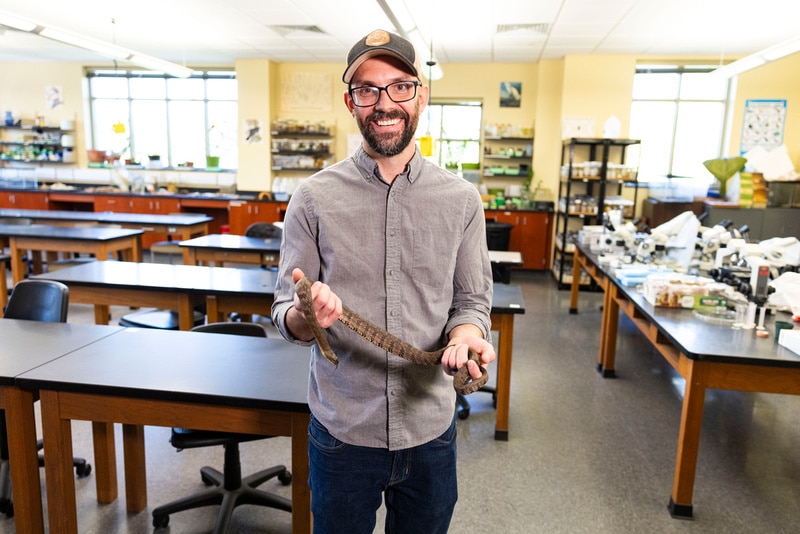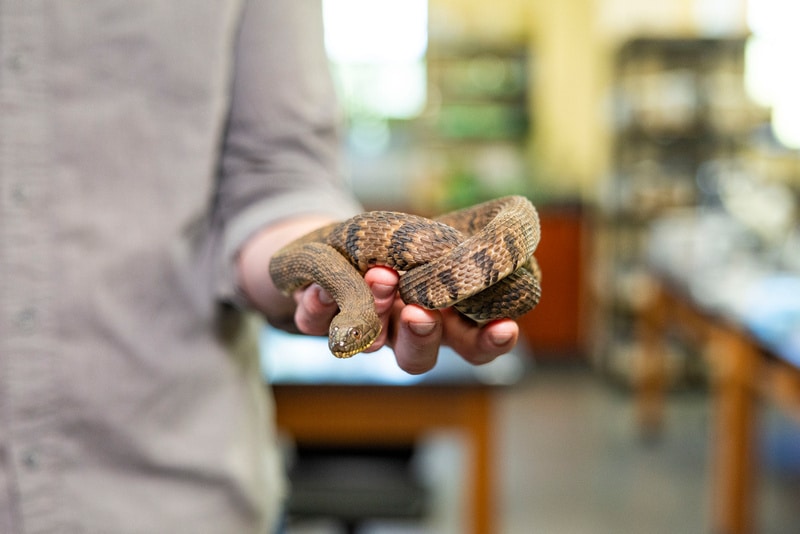 Dr. Jeremy Chamberlain, associate professor of biology at Southern Arkansas University, along with co-authors Dr. Ian T. Clifton and Dr. Matthew E. Gifford, has just published an innovative study in the journal Oecologia entitled “Variable juvenile growth rates and offspring size: a response to anthropogenic shifts in prey size among populations.” This research sheds light on how human-altered environments are affecting predator populations, focusing on the growth rates and offspring sizes of diamond-backed watersnakes.
Dr. Jeremy Chamberlain, associate professor of biology at Southern Arkansas University, along with co-authors Dr. Ian T. Clifton and Dr. Matthew E. Gifford, has just published an innovative study in the journal Oecologia entitled “Variable juvenile growth rates and offspring size: a response to anthropogenic shifts in prey size among populations.” This research sheds light on how human-altered environments are affecting predator populations, focusing on the growth rates and offspring sizes of diamond-backed watersnakes.
The study, which uses populations from fish farms in Arkansas, investigates how changes in prey availability and size, particularly due to fish farming, influence the growth rates of juvenile snakes. Dr. Chamberlain and his team found that watersnakes from populations exposed to larger prey sizes exhibit faster growth rates and produce larger offspring, highlighting how environmental pressures can lead to significant, non-genetic phenotypic changes.
“Our findings suggest that rapid environmental changes caused by human activities, such as aquaculture, can lead to quick and profound phenotypic shifts in local predator populations,” said Dr. Chamberlain. “This has important implications for understanding how wildlife may adapt—or struggle to adapt—to the changing landscapes brought about by human industry.”
The research involved a comprehensive common-garden experiment that demonstrated how initial offspring size and prey consumption are critical factors in juvenile growth rates. Interestingly, the study concluded that these differences are not the result of genetic adaptations, but rather non-heritable responses to prey size differences across populations.
 The findings of this study contribute to the broader understanding of how wildlife responds to human-induced environmental shifts, providing valuable insight into the adaptive strategies predators employ when faced with altered prey landscapes. This study could have far-reaching implications for conservation efforts, as it highlights the necessity of considering rapid phenotypic plasticity in response to environmental changes when designing conservation strategies.
The findings of this study contribute to the broader understanding of how wildlife responds to human-induced environmental shifts, providing valuable insight into the adaptive strategies predators employ when faced with altered prey landscapes. This study could have far-reaching implications for conservation efforts, as it highlights the necessity of considering rapid phenotypic plasticity in response to environmental changes when designing conservation strategies.
For more information or to request a copy of the paper, please contact Dr. Chamberlain at jchamberlain@saumag.edu.
About Southern Arkansas University:
SAU is a leader in biological research and education, fostering innovative studies that contribute to global scientific knowledge. The department of biology offers robust programs and cutting-edge research opportunities for students and faculty alike.
Citation:
Chamberlain, J.D., Clifton, I.T., & Gifford, M.E. (2024). Variable juvenile growth rates and offspring size: a response to anthropogenic shifts in prey size among populations. Oecologia. DOI: 10.1007/s00442-024-05623-x
